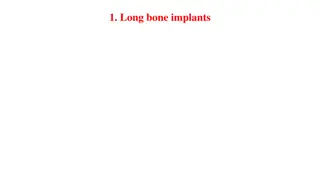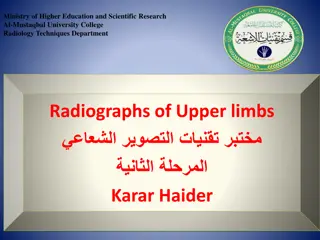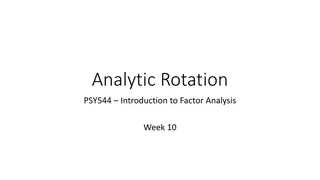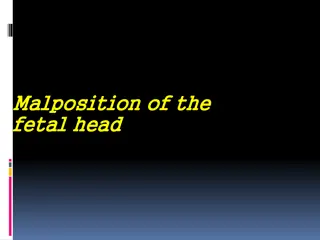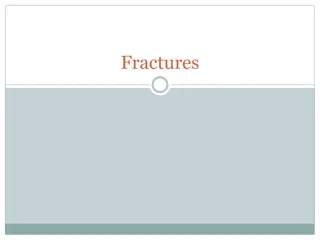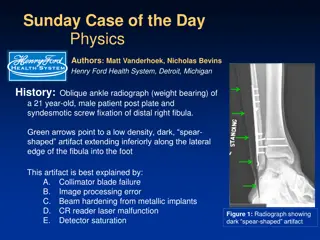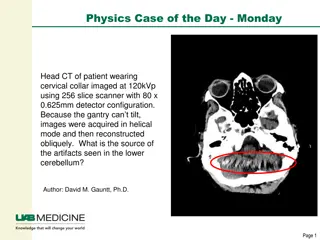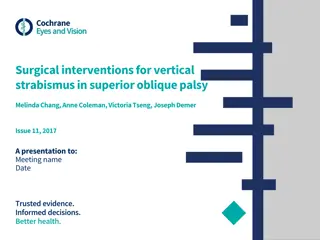Understanding Long Bone Implants and Osteosynthesis Techniques
Fractures in long bones can be categorized based on their form, aiding in prognosis and management. Different types of fractures include comminuted, transverse, oblique, crushing, intra-articular, detachment, and selected fractures. Long bone implants play a crucial role in osteosynthesis, with mate
1 views • 22 slides
Veterinary Anatomy: Tarsal Bone Structure and Ligaments
Veterinary anatomy lesson featuring the composite joint of the tarsus in an ox, detailing the arrangement of short bones in the tarsus and the ligaments involved. Images and descriptions explain the composition of the composite joint, the types of movements it allows, and the ligaments supporting it
3 views • 28 slides
Geographical Skills: Aerial Photographs, Charts, Graphs and Infographics
Aerial photographs are key tools for interpreting land surfaces, with vertical and oblique types used for different perspectives. Locating places on photographs involves dividing them into sections and understanding directions. Sketching aerial photographs requires creating a frame and dividing sect
0 views • 30 slides
Radiology Techniques for Upper Limb Imaging at Al-Mustaqbal University College
Explore radiographic imaging techniques for upper limbs including fingers and thumbs at the Radiology Techniques Department of Al-Mustaqbal University College. Learn about PA, lateral, oblique, and AP views for detailed analysis. Proper positioning and imaging guidelines are provided to ensure accur
0 views • 20 slides
Translation Strategies and Equivalence Models in Modern Translation Studies
In modern translation studies, the concept of equivalence and different translation strategies are explored. Scholars have debated the subjectivity involved in translation, with some advocating for a descriptive approach while others stick to prescriptive discussions of equivalence. Influenced by pa
0 views • 10 slides
Understanding Analytic Rotation in Factor Analysis
Factor analysis involves rotation of the factor loading matrix to enhance interpretability. This process was originally done manually but is now performed analytically with computers. Factors can be orthogonal or oblique, impacting the interpretation of factor loadings. Understanding rotation simpli
0 views • 42 slides
Solving Triangles with Law of Sines
Learn how to solve oblique triangles using the Law of Sines, including the ambiguous case. Practice finding missing sides and angles in triangles without right angles. Explore examples and applications to enhance your trigonometry skills.
0 views • 16 slides
Understanding Occipito-Posterior Position of the Fetal Head
Occipito-posterior position of the fetal head occurs when the head is in one of the oblique diameters with the occiput directed posteriorly. It can be categorized into Right Occipito-Posterior Position (ROP) and Left Occipito-Posterior Position (LOP), affecting 13% of vertex presentations. Causes in
0 views • 32 slides
Understanding Different Types of Fractures and Their Characteristics
Explore various types of fractures such as traumatic, pathologic, compressive, and more through detailed medical images and authentic reports. Learn about the severity of soft tissue damage, classifications by renowned professionals, and the significance of assessing soft tissue injuries. Delve deep
0 views • 28 slides
Understanding the Law of Sines for Solving Oblique Triangles
Explore the Law of Sines to solve oblique triangles efficiently, covering cases like AAS, ASA, and SSA. Learn how to find areas of triangles and apply the Law of Sines to real-life scenarios. Discover the significance of knowing at least one side and two other measures of a triangle.
0 views • 45 slides
Translation Strategies and Principles for Effective Communication
This content covers features and principles of good translation, problems encountered in translation such as lexical and syntactic issues, degrees of approximation, typologies of translation strategies, and the significance of syntactic, semantic, and pragmatic components in translation. It also dis
0 views • 29 slides
Understanding Image Processing Artifacts in Radiography
An oblique ankle radiograph of a patient showed a dark spear-shaped artifact extending from the leg to the foot, which was identified as an image processing error due to a black border imaging algorithm issue. The presence of metal in the leg caused the algorithm to fail, resulting in the artifact.
0 views • 4 slides
Mastering Sketching Techniques: Oblique, Isometric, and Shading Tips
Learn how to create 3D effects in your sketches using oblique and isometric sketching methods, along with shading techniques to add depth and dimension. Master the art of drawing cubes and other shapes with step-by-step instructions and visual examples. Enhance your sketching skills with tips on hat
0 views • 4 slides
Understanding Artifact Sources in Head CT Imaging
Head CT images of a patient wearing a cervical collar show artifacts in the lower cerebellum caused by oblique reconstruction from helical scans due to the gantry's inability to tilt. Dental implants contribute to beam hardening streaks seen in the image, particularly evident in a sagittal view exte
0 views • 5 slides
Surgical Interventions for Vertical Strabismus in Superior Oblique Palsy: A Review
Binocular misalignment in superior oblique palsy often requires surgical interventions to address vertical strabismus, which can lead to visual issues and neck muscle problems. This review assessed the effects of various surgical treatments on individuals with this condition. Despite limited data pr
0 views • 10 slides
Exploring the Law of Sines in Oblique Triangles
Delve into the Law of Sines for solving oblique triangles without right angles, covering cases like AAS, ASA, SSA, and SSS. Understand how to utilize this law to find angles, sides, and areas of triangles, alongside practical applications.
0 views • 37 slides
